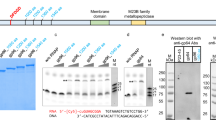Abstract
Infectious pancreatic necrosis virus (IPNV) is an economically important fish pathogen. The virus particles contain two large segments of double-stranded (ds)RNA1–4, which encode four different intracellular primary gene products5,6. The smaller genome segment (‘B’) encodes the largest of these four proteins and the larger genome segment (‘A’) encodes the other three by a mechanism which does not seem to involve post-transla-tional cleavage of a large precursor polypeptide in vivo7. Previous results8,9 have indicated that only two species of mRNA are produced, one from each genome segment8, and that one of these viral mRNAs (that produced from segment B; ref. 7) is monocistronic. The other mRNA, which is transcribed from segment A (ref. 7), encodes three proteins, which may be produced by a mechanism involving multiple initiation and termination sites for translation, rather than post-translational cleavage5–7. To distinguish between these two possible mechanisms, we have studied the translation in vitro of the denatured IPNV genomic dsRNA segments. We report here that the mRNA transcribed from genome segment A is polycistronic.
This is a preview of subscription content, access via your institution
Access options
Subscribe to this journal
Receive 51 print issues and online access
$199.00 per year
only $3.90 per issue
Buy this article
- Purchase on Springer Link
- Instant access to full article PDF
Prices may be subject to local taxes which are calculated during checkout
Similar content being viewed by others
References
Cohen, J., Poinsartd, A. & Scherrer, T. J. gen. Virol. 21, 485–498 (1973).
Dobos, P. Nucleic Acids Res. 3, 1903–1924 (1976).
Macdonald, R. D. & Yamamoto, T. J. gen. Virol. 34, 236–247 (1977).
Dobos, P., Hallett, R., Kells, D. T., Sorensen, O. & Rowe, D. J. Virol. 22, 150–159 (1977).
Dobos, P. J. Virol. 21, 242–258 (1977).
Dobos, P. & Rowe, D. J. Virol. 24, 805–820 (1977).
Macdonald, R. D. & Dobos, P. Virology 114, 414–422 (1981).
Somogyi, P. & Dobos, P. J. Virol. 33, 129–139 (1980).
Mertens, P. P. C., Jamieson, P. J. & Dobos, P. J. gen. Virol. 57, 47–56 (1982).
McCrae, M. A. & Joklik, W. K. Virology 89, 578–593 (1978).
Inglis, C. S., Gething, M. J. & Brown, C. M. Nucleic Acids Res. 8, 3575–3589 (1980).
McCrae, M. A. J. gen. Virol. 55, 393–403 (1981).
Kennedy, S. I. T. J. molec. Biol. 108, 491–551 (1976).
Westaway, E. G. Virology 80, 320–335 (1977).
Gilbert, J., Normura, S., Anderson, C. W. & Khoury, G. Nature 291, 346–349 (1981).
Dobos, P. et al. J. Virol. 32, 593–605 (1979).
Laemmli, U. K. Nature 227, 680–685 (1970).
Carstens, E. B. & Weber, J. J. gen. Virol. 37, 453–474 (1977).
Elder, J. A., Pickett, R. A. II, Hampton, J. & Lerner, R. A. J. Biol. Chem. 252, 6510–6515 (1977).
Author information
Authors and Affiliations
Rights and permissions
About this article
Cite this article
Mertens, P., Dobos, P. Messenger RNA of infectious pancreatic necrosis virus is polycistronic. Nature 297, 243–246 (1982). https://doi.org/10.1038/297243a0
Received:
Accepted:
Issue Date:
DOI: https://doi.org/10.1038/297243a0
Comments
By submitting a comment you agree to abide by our Terms and Community Guidelines. If you find something abusive or that does not comply with our terms or guidelines please flag it as inappropriate.



